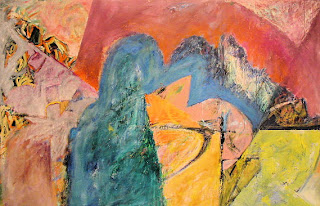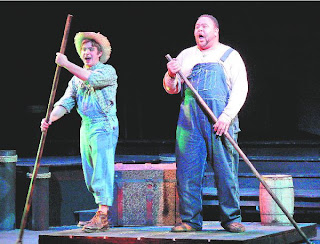
Jennifer Combe's paintings at The Black Front Gallery are ablaze with color.
Anyone who has studied basic color theory knows that temperature is a primary element of color. Blues and greens are cool; reds, yellows and oranges are hot 3/4 all due to associations. For instance, we associate red with fire, and blue with water to put out the fire. It would take a lot of water to put out the fire in these paintings by Combe. Even her blues and greens look hot.
Combe works in series. If you look at her Web site (www.jkcombe.com), you will see a series of paintings of animals, a series of paintings of small squares, and yet another of flower paintings. In this show, she presents a series of paintings of flowers. They're not the same flowers shown on her Web site. They are better. They are abstract and barely recognizable as flowers, consisting of groups of large circular forms that look like roses and clumps of different circular forms that look like snapdragons, all in fiery tones of red, yellow and orange on a background of loosely brushed square and rectangular shapes in a variety of blue and green colors dominated by a hot yellow-green.
It doesn't matter that the subject matter is flowers. In fact, the less they look like flowers, the better the paintings are. That's because Combe's real subject is color and surface, and the more these pictures look like flowers the more distracted the viewer is from the real subject.
The best painting in the show, by far, is a large painting called "Big Red Composition." The flower motif in this painting is almost nonexistent. It is painted on two panels and is approximately 5 square feet. The paint application is gutsy, raw, sloppy, and painterly with great depths of overlapping transparent brush marks. The dominant color is red. This painting is on fire.
It takes only nine paintings to fill the tiny space to capacity. There are four large paintings, approximately 5-by-5 feet; three smaller paintings, about 3 square feet; and one odd rectangular painting. All utilize similar forms and colors. The larger paintings are much stronger than the smaller ones, allowing the hot, hot colors to breathe more and allowing for much greater depth and variety of surface markings. The smaller ones tend toward the overly decorative look of flowers painted on cheap ceramic plates 3/4 saved only by Combe's excellent manipulation of color and surface. She displays a sophisticated grasp not only of color temperature, but also of the tricky use of value keying 3/4 meaning keying all colors to a narrow range of dark and light 3/4 and an equally sophisticated understanding of how to handle varying degrees of opacity and transparency.
Take note: If you read this column on the day this fine rag hits the streets, you have only two more days to hurry down to The Black Front Gallery and see this show.
[The Black Front Gallery, through March 31 11 a.m. to 6 p.m., 106 Fourth Ave. E., Olympia, www.theblackfrontgallery. com]















